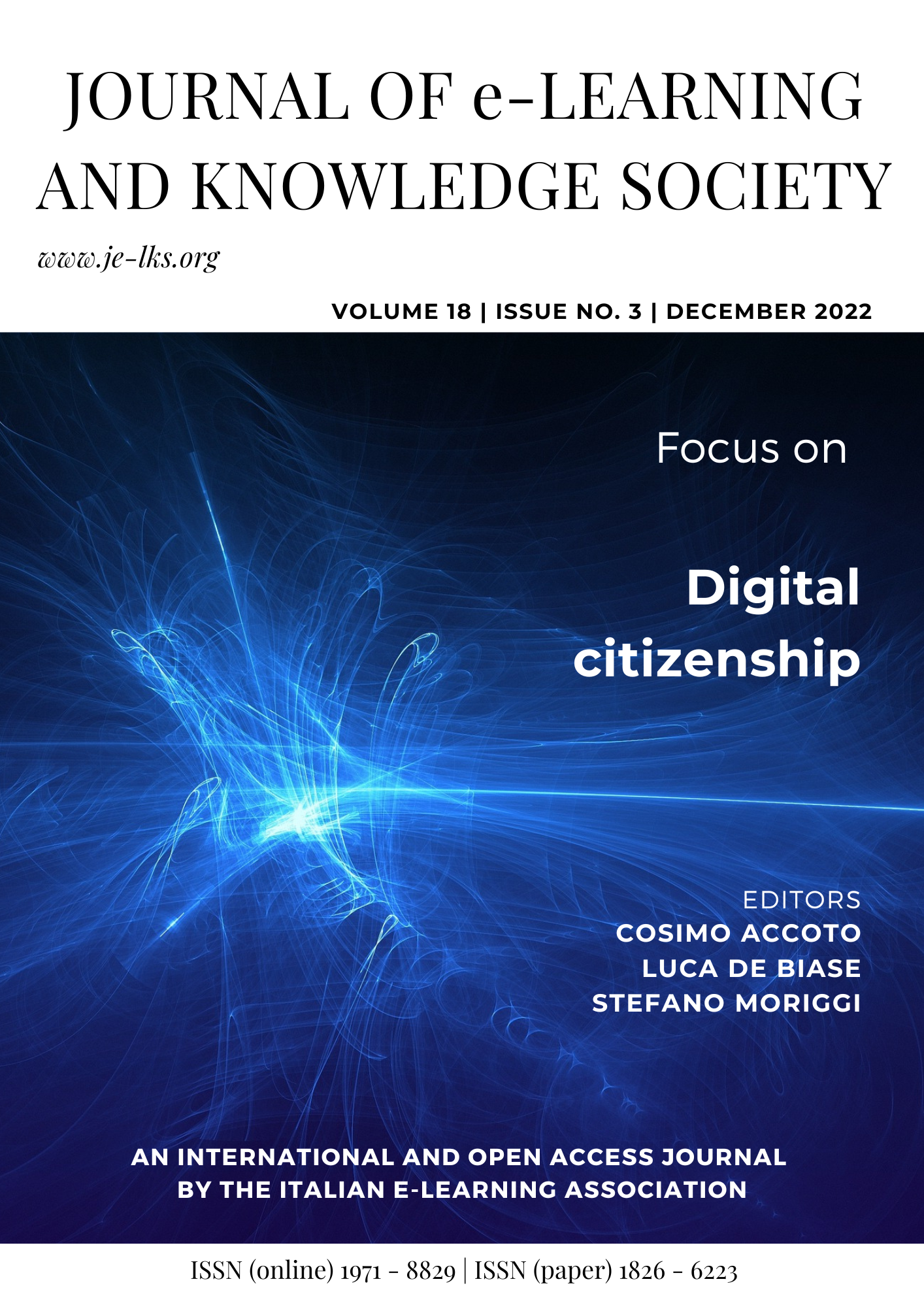Main Article Content
Abstract
This article, in the form of an essay, proposes a new model of digital citizenship starting from ethical-social assumptions and bases, an alternative point of view through which the development of digital skills and new technologies is supported by anthropological and cultural paradigms. This becomes the only possible context where to develop a sustainable, shared and egalitarian digital citizenship, epitome of the transformation of today’s society, which is increasingly connected to the world of technological innovations. The synergy of different activities, in fields and contexts not always linked to each other, develop a fertile network on which to enhance the attitude to a positive and critical use of digital tools. The proposed model aims to establish six key points, six focuses: governance, prevention, network and social ethics, education and research, all operating within a conscious sharing of real ethical-social rules, recognized as a primary source by society. The represented sectors of intervention move simultaneously, in a circular, dynamic, centripetal convergence; only the joint effort of all areas of intervention will be able to achieve a real digital citizenship permeated by a conscious and active ethical awareness. The discussion also focuses on training and on the disparities relating to accessibility and use in the technological field, detecting the inequalities still deeply rooted in the territory and identifying Universal Design for Learning as a possible inclusive model.
Keywords
Article Details

This work is licensed under a Creative Commons Attribution-NonCommercial-ShareAlike 4.0 International License.
The author declares that the submitted to Journal of e-Learning and Knowledge Society (Je-LKS) is original and that is has neither been published previously nor is currently being considered for publication elsewhere.
The author agrees that SIe-L (Italian Society of e-Learning) has the right to publish the material sent for inclusion in the journal Je-LKS.
The author agree that articles may be published in digital format (on the Internet or on any digital support and media) and in printed format, including future re-editions, in any language and in any license including proprietary licenses, creative commons license or open access license. SIe-L may also use parts of the work to advertise and promote the publication.
The author declares s/he has all the necessary rights to authorize the editor and SIe-L to publish the work.
The author assures that the publication of the work in no way infringes the rights of third parties, nor violates any penal norms and absolves SIe-L from all damages and costs which may result from publication.
The author declares further s/he has received written permission without limits of time, territory, or language from the rights holders for the free use of all images and parts of works still covered by copyright, without any cost or expenses to SIe-L.
For all the information please check the Ethical Code of Je-LKS, available at http://www.je-lks.org/index.php/ethical-code
References
- Backstrom, L., Boldi, P., Rosa, M., Ugander, J., Vigna, S. (2012, June). Four degrees of separation. In Proceedings of the 4th Annual ACM Web Science Conference (pp. 33-42).
- Backstrom, L., Karrer, B., Marlow, C., Ugander, J., (2011). The anatomy of the facebook social graph, from http://arxiv.org/abs/1111.4503
- Baroni, F., Lazzari, M. (2013). Tecnologie informatiche e diritti umani per un nuovo approccio all’accessibilità. Italian Journal of Disability Studies, 1(1), 79-92.
- Baudelaire, C. (2014). I fiori del male e altre poesie. Bari: Einaudi.
- Boccia Artieri, G. (a cura di) (2015). Gli effetti sociali del web. Forme della comunicazione e metodologie della ricerca online. Milan: Franco Angeli.
- Buccieri, A. (2004). Le voci nella rete. Per una sociologia delle comunità virtuali. Pisa: Plus.
- Calvani, A. (2010). La competenza digitale: un modello di riferimento per la scuola. In: A. Calvani, A., Fini, & M., Ranieri, La competenza digitale nella scuola. Modelli e strumenti per valutarla e svilupparla. Trento: Erickson, 35 – 63.
- Calvani, A. (2013). L’innovazione tecnologica nella scuola: come perseguire un’innovazione tecnologica sostenibile ed efficace. LEA – Lingue e letterature d’Oriente e d’Occidente, 2, 567– 584.
- Calvani, A., Bonaiuti, G., & Pettenati, M. C. (2011). Instructional Principles, Universal Learning Design and the role of technologies. In International Conference ICT for inclusive learning: the way forward (pp. 229-233). Athens, Greece: Euracademy Association. Euracademy Association.
- Durkheim, E. (2008). Le regole del metodo sociologico, Sociologia e filosofia. Bari: Piccola biblioteca Einaudi.
- European Court of Auditors (2021) from https://www.eca.europa.eu/lists/ecadocuments/rw21_02/rw_digital_skills_it.pdf
- European Commissiom, JRC, (2022). DigComp 2.2: The Digital Competence Framework for Citizens from https://publications.jrc.ec.europa.eu/repository/handle/JRC128415
- Galimberti, U., (2011). Freud, Jung e la psicoanalisi. Turin: La biblioteca di Repubblica.
- Guglielman, E. (2011). Verso l’«e-learning» inclusivo. Primi contributi per la costruzione di linee guida per l’accessibilità metodologico-didattica. Journal of Educational, Cultural and Psychological Studies (ECPS Journal), 2(4), 167-186.
- Italian Commission for internet rights and duties (2015). Declaration of internet rights, from https://www.camera.it/application/xmanager/projects/leg17/commissione_internet/TESTO_ITALIANO_DEFINITVO_2015.pdf
- Khun, T. (1999). La struttura delle rivoluzioni scientifiche. Torino: Einaudi.
- Mace, R. (1985). Universal Design, Barrier-free Environments for Everyone. Los Angeles, CA: Designers West.
- McGuire, J. M., Scott, S. S., & Shaw, S. F. (2003). Universal design for instruction: The paradigm, its principles, and products for enhancing instructional access. Journal of postsecondary education and disability, 17(1), 11-21.
- Morin, E. (2002). Il metodo. L'identità umana. Milan: Raffaello Cortina.
- Morin, E., Cotroneo, G., & Gembillo, G. (2003). Un viandante della complessità. Morin filosofo a Messina, a cura di Anselmo A., Messina: Armando siciliano Editore.
- Morin, E. (2008). Lo spirito del tempo. Milan: Meltemi.
- Nida-Rümelin J., & Weidenfeld, N. (2019). Umanesimo digitale. Un’etica per l'epoca dell'Intelligenza Artificiale. Milan: Franco Angeli.
- Rivoltella, P.C. (2020). Tecnologie di comunità. Brescia: Editrice Morcelliana.
- Salamone, R. (2021). I pericoli del web per i giovani e gli adolescenti. Linee-guida per un corretto uso della rete. Rome: Alpes.
- Sennett, R. (2019). Building and Dwelling. Ethics for the City. London: Penguin.
- Simmel, G. (1995). La metropoli e la vita dello spirito. Rome: Armando Editore.
- Urbinati, N. (2011). Liberi e uguali. Contro l’ideologia individualista. Rome-Bari: Laterza.

